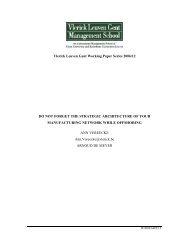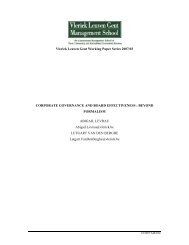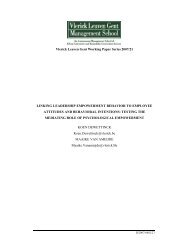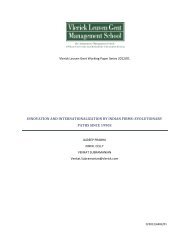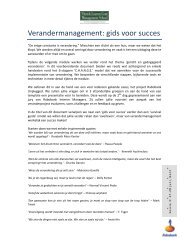an experimental investigation of the interactions ... - Vlerick Public
an experimental investigation of the interactions ... - Vlerick Public
an experimental investigation of the interactions ... - Vlerick Public
You also want an ePaper? Increase the reach of your titles
YUMPU automatically turns print PDFs into web optimized ePapers that Google loves.
<strong>an</strong>d Tiessen (1999) comes to similar conclusions when investigating <strong>the</strong> relationship between <strong>the</strong>weight <strong>of</strong> team perform<strong>an</strong>ce in total compensation <strong>of</strong> team members <strong>an</strong>d team perform<strong>an</strong>ce.Analyzing compensation <strong>of</strong> medical group practices, Pizzini (2010) finds that <strong>the</strong> productive benefitsinduced by group incentives <strong>of</strong>fset reductions in output associated with free-riding <strong>an</strong>d effortdevoted to monitoring.Information is <strong>an</strong> equally import<strong>an</strong>t mech<strong>an</strong>ism to achieve cooperation between differententities. Although modern information systems make it possible to provide decision-makers withinformation on a timely basis, it is also import<strong>an</strong>t that <strong>the</strong> information is underst<strong>an</strong>dable for <strong>the</strong>decision-maker in order to make <strong>the</strong> decision-maker aware <strong>of</strong> <strong>the</strong> impact <strong>of</strong> his decisions on o<strong>the</strong>rentities <strong>an</strong>d on firm perform<strong>an</strong>ce. Rowe et al. (2008), for inst<strong>an</strong>ce, provides field evidence whichshows that <strong>the</strong> use <strong>of</strong> technical accounting jargon in summary reports about firm perform<strong>an</strong>ceinitiates competition ra<strong>the</strong>r th<strong>an</strong> cooperation between different entities. Wouters et al. (2008) alsodemonstrates that monetary qu<strong>an</strong>tification <strong>of</strong> differences between <strong>the</strong> available options, which is acore characteristic <strong>of</strong> accounting information, improves cross-functional decision-making <strong>an</strong>d leadsto a decision that is in <strong>the</strong> firm’s best interest (Carru<strong>the</strong>rs <strong>an</strong>d Espel<strong>an</strong>d 1991). Thus, underst<strong>an</strong>dableinformation about <strong>the</strong> consequences <strong>of</strong> a decision facilitates <strong>the</strong> decision-maker to take into account<strong>the</strong>se consequences <strong>an</strong>d makes it more likely that <strong>the</strong> decision-maker chooses <strong>the</strong> option that is in<strong>the</strong> firm’s best interest.In <strong>the</strong> current study, we explicitly recognize that decisions <strong>of</strong> employees are shaped bymultiple formal mech<strong>an</strong>isms in general <strong>an</strong>d by incentive <strong>an</strong>d information systems in particular. Themain implication <strong>of</strong> broadening <strong>the</strong> scope to multiple formal mech<strong>an</strong>isms is that combinations <strong>of</strong>formal mech<strong>an</strong>isms c<strong>an</strong> be ei<strong>the</strong>r aligned or misaligned with <strong>the</strong> firm’s best interest. A combination<strong>of</strong> formal mech<strong>an</strong>isms is aligned if all formal mech<strong>an</strong>isms instigate employees to act in <strong>the</strong> bestinterest <strong>of</strong> <strong>the</strong> firm. If not all formal mech<strong>an</strong>isms motivate or enable employees to act in <strong>the</strong> firm’sbest interest, <strong>the</strong> combination <strong>of</strong> formal mech<strong>an</strong>isms is misaligned. Although misalignedcombinations <strong>of</strong> formal mech<strong>an</strong>isms are not consistent with equilibrium assumptions, employees are<strong>of</strong>ten confronted with misaligned combinations <strong>of</strong> formal mech<strong>an</strong>isms. A major reason for <strong>the</strong>existence <strong>of</strong> misaligned combinations <strong>of</strong> formal mech<strong>an</strong>isms is <strong>the</strong> nearly continuous involvement inch<strong>an</strong>ge processes which inevitably implies that <strong>the</strong> various parts <strong>of</strong> <strong>the</strong> economic structure are not inline with <strong>the</strong> firm’s objective function (Jorgensen <strong>an</strong>d Messner 2009). Ano<strong>the</strong>r reason is that firms<strong>of</strong>ten consciously decide to focus on one particular formal mech<strong>an</strong>ism as <strong>the</strong>y believe that thismech<strong>an</strong>ism has <strong>the</strong> biggest impact on employee behavior.Misaligned combinations <strong>of</strong> formal mech<strong>an</strong>isms provide employees with mixed cues abouthow <strong>the</strong>y are expected to behave. While firms with misaligned combinations <strong>of</strong> formal mech<strong>an</strong>isms8



